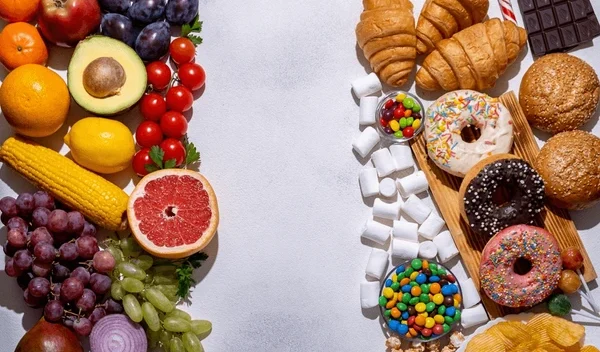Who can resist the joy of savoring something sweet after a meal or during a moment of happiness? Chocolates, candies, and desserts bring us together during celebrations, reminding us that sweets are not just treats, but symbols of joy and togetherness!
But we never give a second thought to how much to eat. We all know that sugar is the main energy source that helps our brain and other body organs function properly, but what if we eat more than the recommended amount?
Alarmingly, India has the second highest childhood obesity rate in the world, and this alarming trend is directly linked to dietary factors such as the consumption of sugary snacks and drinks specifically designed for children.
According to recommendations from the European Nutrition Committee, children and adolescents (ages 2 to 18) should consume less than 5% of their energy intake as free sugar (added sugar). Young children under the age of two should consume considerably less free sugar. Children ages 2 to 7 should consume 15 to 20 grams of sugar, those ages 7 to 13 should have 22 to 27 grams, and those ages 13 to 19 should consume 27 to 37 grams. (1 teaspoon = 4 grams)
Yes, every human body is different, and so it responds differently. Some people have a high blood sugar response to one type of food, while others do not. The human body can only handle a limited amount of sugar.
According to the American Heart Association, men should consume no more than 9 teaspoons of added sugar daily, while women should limit their intake to 6 teaspoons. Be mindful of your sugar consumption to ensure a healthy and balanced lifestyle. Read more
What is sugar?
Sugar is sucrose, a soluble carbohydrate made up of two sugars- glucose and fructose- that are naturally found in fruits, vegetables, dairy products, and nuts.
But what are these white crystals you keep in your kitchen? This is also called sugar but not natural; it’s commercially produced from sugarcane and sugar beets (not to be confused with beetroot).
Glucose and fructose are the sugars that we commonly consume daily. Glucose is majorly metabolised by every cell of the body but here comes fructose which is only metabolized by the liver. These carbohydrates are present in fruits, vegetables, dairy products, and grains. Sucrose is also the common sugar present in sugarcane, sugar beets, dates, etc.
Now imagine if you are eating too much fructose-containing food (processed), what is going to happen with your liver cells? More fructose means more fat cells, and then it will make your liver a fat liver! So, PROTECT YOUR LIVER.

What is added sugar?
Added sugar is the artificial form of sugar extracted from sugarcane, sugar beets, and corn and processed into white crystalline form (sucrose) with a negligible amount of water content, about 0.5%. Though the sources of natural and processed sugar are the same, what makes them different is that refined sugar contains no fiber and nutrients.
Added sugars are only added to the foods to enhance the taste, flavor, texture, and shelf life of the product found on the supermarket shelves. About 75% of packed foods contain added sugar.
Top sources of added sugars- soft drinks, fruit drinks, cookies, cakes, cereals, yogurts, etc.
Others are ketchup, bread, soup, etc.
Types of added sugar in your food
Any food packed in colorful wraps attracts you to buy from the market and you eat in large chunks without checking its label. Isn’t it? There is sugar disguised with several names you may have seen.
Here is the list of common added sugars
- High-fructose corn syrup (HFCS)
- Sucrose
- Invert sugar
- Corn syrup
- Fruit juice concentrates
- Malt sugar
- Molasses
- Corn sweeteners
- Brown sugar
- Agave nectar
- Honey
- Raw sugar
- Dextrose
- Maltose
- Dextrin
- Rice syrup
- D-ribose
- Glucose solids
- Confectioner’s sugar (powdered sugar)
Sugar is the main source of energy in the body and plays an important role in maintaining a stable glucose level. Natural sugars are easily digested and metabolized while added sugar quickly gives energy then drops lead to more glucose levels in the bloodstream if taken in large quantities and the rest gets stored in the liver.
What is the impact of sugar overconsumption on health?
It is true overconsumption of anything is dangerous until it is taken in a moderate amount, it’s ok! Likewise, added sugar, especially in liquid form is unhealthy and linked to a wide range of health conditions immediately or later in life. Obesity, cardiovascular diseases, type 2 Diabetes Mellitus (in which your body doesn’t use insulin properly, resulting in unusual blood sugar levels), and many more like chronic diarrhea, bloating, and growth faltering (where children do not gain enough weight for normal healthy development.)
Another cause is tooth decay due to free sugar and acidity. So, by limiting your sugar intake, you can prevent the acid from attacking the enamel that makes your teeth appear yellow. Read more
Understanding added sugar on Nutrition facts label
The nutrition facts label shows the nutritional content, serving size, and calories for the recommended serving of food products. Nutritional labeling helps the consumer to understand and follow the Dietary Guidelines for Americans (DGAC) for consuming up to 200 calories or 10% of total calories per day of added sugar.
Let’s understand this
Added sugar is not only listed in the form of grams but also as a Percent Daily value (%DV). Daily value tells how much nutrients are found in one serving of the product.
See the image shown below:
The total sugar mentioned here is 15 g which is the total amount of sugar present in the product containing both natural sugar and added sugar. Having the word “includes” before added sugars represents that added sugar is included in no. of grams of total sugar in the product.
So, total sugar – 15 g,
sugar found in the product – 7 g and
added sugar – 8 g (sweeteners)

Thus, Nutrition facts labels help uncover the consumer in many factors such as food selection, what to eat by checking the recommended limits, what nutrients you are getting, and if you have health conditions or following any diet.
So, next time check the NUTRITION FACTS LABEL when you buy any packed food!
Conclusion
Sweets can bring joy and togetherness, but it’s crucial to be mindful of sugar consumption, especially among children, to combat rising obesity rates and promote a healthier lifestyle. Balancing enjoyment with moderation, sugar consumption can be acceptable, excessive intake, particularly of added sugars in liquid form, poses significant health risks, including obesity, diabetes, and dental issues. Reducing sugar intake is essential for maintaining overall health and preventing various chronic conditions.


